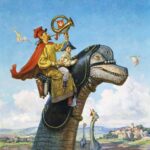
Highlight and center light
First it is important to understand what highlights are—and what they’re not.
Highlights are specular reflections of the light source on shiny surfaces. In specular reflection, light rays bounce off the surface at the same relative angle that they approach it, like a billiard ball bouncing off a side cushion. In diffuse reflection, light rays bounce away in all directions. Diffuse reflection is typical of a matte surface, such as an egg.
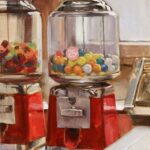
I painted this gumball machine while sitting in a coin laundry. There was a little highlight in the center of each ball, a reflection of the fluorescent lights above me. The highlights are even stronger in the chrome trim.
Where do highlights appear?
Unless the sun is coming from directly from behind you, the highlight appears in a different location than the center light. The highlight generally appears at a point closer to your eye than the center light. Unlike the center light, the position of the highlight depends on your point of view. The same highlight often appears differently to your right eye compared to your left eye.
Imagine placing a pocket mirror beside the object and angling the mirror so that it reflects the light source back into your eye. If the surface is shiny enough, any plane on the form parallel to the plane of the mirror will reflect a highlight back to you.
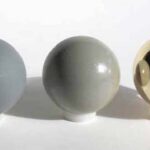
The effect of the surface
The shinier, oilier, or wetter the surface, the brighter the highlight. That’s why eyes, lips, and the tips of noses have brighter highlights than cheeks do. A matte surface with only diffuse reflection, such as a sweater or a sand dune, will not have any highlights at all.
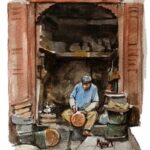
Painted on location in Fes, Morocco, the highlights in this coppersmith’s stall are brightest on the polished copper and silver. I had to run washes over all the areas but these two or three spots of pure white paper to carry the effect.
In other words, imagine how you would paint a regular matte-surfaced apple. If the same apple were given a high-gloss wax coating and you painted it again, you’d have to consider the normal modeling factors plus the specular effects
The effect of the light source
Highlights are also greatly influenced by the character of the light source. On a highly reflective silver surface, such as a spoon or a silver teapot, the highlight color will mirror the light source. A soft, cool light source such as a large window, will yield a large, cool highlight, while a hard, small, warm source such as the sun will result in a sharp, small, warm highlight. A highlight is typically the lightest value in the entire painting, nearly as light as the light source itself, and lighter than the center light.
Let’s look at the idealized example of a sculpted head covered with reflective silver paint. A green light shines from the left, a magenta light shines from the right front, and a blue light comes in from farther to the right. Even with three different light sources, the lights don’t really mix very much on the planes of the head. Instead, each light source accounts for a separate array of specular highlights, and each set of highlights defines a set of parallel planes. Our brains are able to construct an understanding of form based on these fragmentary bits of information.
Four rules of specular surfaces
1. The more reflective the surface, the brighter the highlights and the broader the range of values you need to paint it.
2. The size of the highlight is influenced by the curvature of the surface of the form. The more highly curved the surface, the smaller the highlight; the flatter the surface, the larger the highlight.
3. Whether you’re rendering digitally or traditionally, the specular pattern is a separate layer added on top of the usual modeling factors that you use to render the object.
4. The highlights on any glossy form are not pure white, but rather a combination of the color of the source and the local color of the object.
Annular Highlights
Highlights don’t form only on solid objects. They also can form into a pattern of circles made up of individual scratches on metal or twigs in trees. For example, when you look into the maze of ice-covered bare branches of a forest in winter, you’re only seeing a fraction of the detail. The light illuminates only a few of these branches while most of them blend invisibly into the general gray.
Only the branches that are perpendicular to the direction of the light catch the highlight. The illuminated twigs align into concentric rings around the center point of the light source. These annular highlights help the viewer to subconsciously orient to the location of the light source. The three arrows in the photo are placed perpendicular to the illuminated twigs. If you follow the arrows, they lead to the location of the sun.
You can also observe annular highlights in the scratches of a well-used stainless-steel surface, like the cookie sheet and pot lid, below, left. Look for them in the window of a passenger train on a late afternoon, in a spiderweb on a dewy morning, in a cornfield lit by a setting sun, or on tree branches surrounding a streetlight on a rainy night.
Tips for painting highlights
1. In watercolor, since highlights are the lightest values, they must be left as unpainted white paper, masked out from the start, or applied with gouache at the last.
2. In oil paintings, highlights should be saved for the last, like a garnish of chives or a dash of parmesan cheese on a finished entrée. People observing John Singer Sargent said he saved highlights for the final strokes, considered them carefully, and used thick, heavy impasto for the highlights on jewelry, fingernails or eyes.
3. Avoid a lavish use of highlights. Highlights are like salt. A little makes the food tasty, but too much ruins it.
Oil Painting
Mobile Masters Make Art Instruction Accesible to Artist Anywhere
FIGURE PAINTING WORKSHOP AT THE WOODLANDS ART LEAGUE, Sept. 8th-12th/14
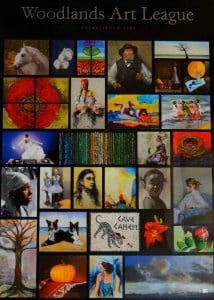 The Woodlands Art League, www.woodlandsartleague.org , a 30+ year old, nonprofit visual art organization that operates in the Woodlands Tx,, was visited by Clayton J. Beck III, one of America’s more acclaimed and recognized artists. The Woodlands Art League is proud of housing more than 300 members, whose careers have been notably carved and enhanced by the training and knowledge visiting masters have provided throughout the years. Clayton, who was teaching his third workshop at WAL, is one of those artists who has enriched the league’s history not only by means of his unconventional training philosophy but also with his professional advice related to the improvement of the physical space necessary to produce better quality art, lighting, space distribution, etc. Robert Liberace, Judy Carducci, and many other masters have pitched in to make art instruction accessible to a whole Houston community, thus facilitating the means of progressive artistic development for all, and the cultural enhancement of the entire area.
The Woodlands Art League, www.woodlandsartleague.org , a 30+ year old, nonprofit visual art organization that operates in the Woodlands Tx,, was visited by Clayton J. Beck III, one of America’s more acclaimed and recognized artists. The Woodlands Art League is proud of housing more than 300 members, whose careers have been notably carved and enhanced by the training and knowledge visiting masters have provided throughout the years. Clayton, who was teaching his third workshop at WAL, is one of those artists who has enriched the league’s history not only by means of his unconventional training philosophy but also with his professional advice related to the improvement of the physical space necessary to produce better quality art, lighting, space distribution, etc. Robert Liberace, Judy Carducci, and many other masters have pitched in to make art instruction accessible to a whole Houston community, thus facilitating the means of progressive artistic development for all, and the cultural enhancement of the entire area.
Clayton, walked in with a confidence that is at the same time intimidating and reassuring. New artists were not sure what to make of his well-worn out hat which didn’t seem necessary in this “dark cave”, as he calls the wall to wall mirrored studio where WAL currently functions. As he introduced himself and the workshop, his eccentricities became less eccentric and turned into logical statements. Clayton, reminded us, artists, that nothing that shows up in the canvas is a mistake or an accident but the result of a thought we consciously or unconsciously deposit in the painting surface and that in order for our art to improve we have to recognize what those thoughts are and change them. He pointed out that not having a goal to strike for, at the beginning of a painting session is like getting in a car and start driving not knowing where you are going.
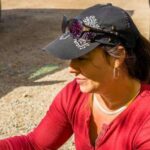 All artists have at one point or another attempted to do color charts but being frustrated we dropped the chore off the list. Clayton encouraged us all to complete them and used them. Debra Latham, one of the artist attendees, from Kingwood, Texas, when asked about the most important thing she had learned from Clayton’s workshop, puts it this way: “The biggest thing I learned was the importance of doing color charts. I’ve only dabbled with them a bit in the past but never to the extent he had gone to. He had such an elaborate way of doing them that I had never seen before. That is one thing on my near future “to-do” list”.
All artists have at one point or another attempted to do color charts but being frustrated we dropped the chore off the list. Clayton encouraged us all to complete them and used them. Debra Latham, one of the artist attendees, from Kingwood, Texas, when asked about the most important thing she had learned from Clayton’s workshop, puts it this way: “The biggest thing I learned was the importance of doing color charts. I’ve only dabbled with them a bit in the past but never to the extent he had gone to. He had such an elaborate way of doing them that I had never seen before. That is one thing on my near future “to-do” list”.
 Is it in the light or is it in the shadow? All artists wrestled with that question while we attempted to look at the model as dispassionate as we could to avoid falling into the trap of painting eyes, mouths and hair instead of the patterns of the light and shadow, lost and found edges. We tried to take ownership of Clayton’s remarks, almost never addressed to an individual attendee but to the group in general, prompting us to put the brushes down and observe the model to collect certain information, before we pick them up again and decide where the next brushstroke is supposed to go.
Is it in the light or is it in the shadow? All artists wrestled with that question while we attempted to look at the model as dispassionate as we could to avoid falling into the trap of painting eyes, mouths and hair instead of the patterns of the light and shadow, lost and found edges. We tried to take ownership of Clayton’s remarks, almost never addressed to an individual attendee but to the group in general, prompting us to put the brushes down and observe the model to collect certain information, before we pick them up again and decide where the next brushstroke is supposed to go.
Is It In the Light? Oil on linen, 20×16, and exercise on light
Hilda Rueda. www.hruedart.webs.com
Workshops like the one offered at WAL by Clayton are valuable for artists of every level. Beginners and advance students take pride on absorbing or recalling knowledge that will help them improve their artistic careers. Suzie Baker, an accomplished and nationally awarded artists, who also participated in the week- long course expresses her foremost lesson as follows:
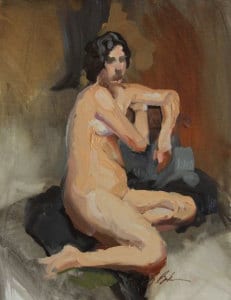 “During Clayton’s workshop, he mentioned several challenges as ways to break out of old ways of thinking, one challenge was to create a painting with no more than 10 brushstrokes per model session. So, let’s do the math: 6 session, 25min each, 10 strokes max per session, that’s 60ish strokes. The economical nature of this way or painting required a deliberate thoughtfulness. I had to spend more time mixing the right value and color of paint, choosing the right brush and amount of paint to load onto that brush, planning the brush stroke (angle, direction of pull and pressure of the stroke). The challenge was as rewarding as it was nerve wracking. Now, I just need to keep it up when Clayton isn’t watching over my left shoulder!”
“During Clayton’s workshop, he mentioned several challenges as ways to break out of old ways of thinking, one challenge was to create a painting with no more than 10 brushstrokes per model session. So, let’s do the math: 6 session, 25min each, 10 strokes max per session, that’s 60ish strokes. The economical nature of this way or painting required a deliberate thoughtfulness. I had to spend more time mixing the right value and color of paint, choosing the right brush and amount of paint to load onto that brush, planning the brush stroke (angle, direction of pull and pressure of the stroke). The challenge was as rewarding as it was nerve wracking. Now, I just need to keep it up when Clayton isn’t watching over my left shoulder!”
Suzie Baker, www.suziebaker.com
“Keli in 60 Strokes or Less, 20 x 16“, Oil on Linen, 2014.
The week dwindled down as we attempted to recognize our own mistaken perceptions. We are determined to eradicate all those thoughts and habits, which although feel comfortable, hinder our progress and make us repeat the same mistakes over and over, piece after piece.
The guidance Clayton, and other masters, have provided us with, is invaluable, not only individually but as an art community which intends to be true to its mission of promoting the visual arts, enriching the general community trough art education and offering our artists easy access to professional instruction. We believe it is possible to make art available to all and it is through workshops with traveling masters that big groups can be reached at a reasonable price and at convenient locations and thus the goal of art-educating all can be achieved. Isn’t this the globalization of our art world? We genuinely so hope.
What’s the Concept?
Paul Strisik was a master artist and teacher. He authored a couple of important books:
The Art of Landscape Painting and Capturing Light in Oils. I believe you will find his views about painting helpful. Foremost, before beginning a painting, he stressed having a clear “conception of the subject”. I call it “your painting concept”.
What is meant by a “painting concept” and how is it determined? Let me explain.

When someone designs and builds a house or just purchases existing blueprints…before any of that…a decision has been made, an idea is finalized as to the style of house desired. It might be a colonial, ranch, country, contemporary, or Victorian; whatever the choice, that decision is the concept. It is called that because everything that follows is a result of that choice.
For example, if the concept is Victorian but all the design and building choices are ranch, will the result be Victorian or ranch? Obviously, it will be ranch. What happened? The original concept was not adhered to.

Similarly, for us artists, if the decision is to depict a landscape shrouded in fog but the painting actually produced contains intense color and high value contrast, the concept and finished piece have become incompatible.
So, even before the canvas is selected, a decision must be made as to what we want to communicate. Once the concept is established, don’t deviate from it or the likely result will be a confusing, discordant painting, or one significantly different from the original concept/idea. I don’t want to leave the impression that deciding upon a concept is always easy and comes naturally. Many times, the subject itself will clearly reveal a concept for you…the overall design, dramatic lighting affects, and interesting color harmonies are but a few…but other times, as in the examples below, it really takes some thought.
Here are a few of my paintings illustrating the point. As you can see, the photo was only the starting point. Imagination took over from there. Each achieved painting is preceded by the photo used to inspire the final work; I call it the “photo concept” even though it merely records the subject. Paul Strisik says, the real measure of an artist is what we do with it.
Here are some helpful tips for determining a clear concept:
- Paint what you enjoy and understand. Painting is difficult enough, so begin with something that stirs your soul.
- Think. What do you want to say? What made you stop to paint, sketch, or photograph this scene in the first place? Fine painting is more than an emotional outburst.
- What is it about the subject that deeply and instinctively appeals to you? Some possibilities are: composition, color, lighting (overall mood/value relationships), and the emotion activated within you.
As you can see from all of the above images, my motivation was inspired by the composition. From that point, I brought my concept of the subject to the final work.
Diane Massey Dunbar Revisited
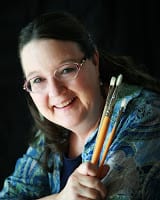
To my mind, no one paints glass better than Dianne Massey Dunbar. Her depiction of things transparent is very carefully observed and yet painted with such intuitive confidence, dexterity, boldness, clarity, and excitement that one just marvels at her ability.
I first interviewed Dunbar in August 2012, and at that time only revealed half of the interview. Now, with a few additional questions, here is the remainder of that amazing interview.
Read Part I of Dunbar’s interview here
What would be your definition of art?
To me, art in its broadest sense includes music, dancing, acting, photography, painting, writing, and the like. It is a personal expression of oneself that generally involves creativity and honesty and an audience. It almost always requires a degree of skill. It is also, invariably, the end result of a process.
Narrowing the definition to drawing and painting, to me art is the creation of an image personal to the artist that is intended as a visual dialogue with an audience. When I stop and contemplate art, it is easy to think of eloquent paintings that have been carefully designed and executed. However, I have seen many rough drawings by children that have deeply touched me. So, I guess I would say that if a painting or drawing reasonably incorporates the principles of drawing and design and craftsmanship, and further inspires in me as a viewer a sense of awe or excitement, interest, beauty, or involvement…and if it is intended to be art, I would call it art.
Are you saying then that you believe art is really in the eye of the beholder?
In my opinion, everyone is entitled to his or her own definition of art. For me personally, I agree and disagree with the statement “art is in the eye of the beholder”. That phrase seems to infer our personal likes and dislikes. I do believe that our tastes influence what we enjoy in the way of art, if we are attracted to a particular painting, whether we like thick or thin paint, still life or landscapes, realism or abstract. It is our emotional response to a painting.
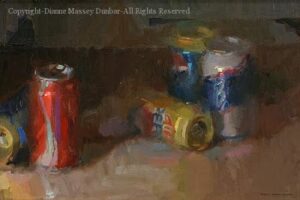
Can there be art if it doesn’t communicate with an audience, in other words, if it can’t be understood?
In order to answer this, I need to define “understood”. One might not recognize the objects in a drawing or painting, or fully understand what the artist was trying to accomplish or communicate, but that does not mean it’s not art. For example, a person that is not versed in biblical stories might not understand religious art. However, I think most people would agree that there are numerous examples of wonderful religious art. Another example is prehistoric art. I may not understand the symbols, recognize the figures or the animals, but I can still appreciate the lines and design. And, many people do not enjoy abstract art but once again that does not discredit it. Understanding a painting has absolutely nothing to do with the subject matter, and everything to do with the visual elements and execution of the painting. So, even if I do not understand the subject matter, I can still appreciate the shapes, the drawing, the lines, the texture, the design, and in that way it still communicates with me.
To be art it must be able to be understood from a purely rational point of view and be organized to create a visual statement. If a drawing or painting is so disorganized that I am unable to understand the visual elements, then I do not think it meets any definition of art. All art, including abstract art, must have drawing, shapes, and values. One can study the painting to see if it is balanced, and if the values and composition are working. Lacking any visual organization so that there are no shapes, values or drawing, well, it would be difficult to call it art.
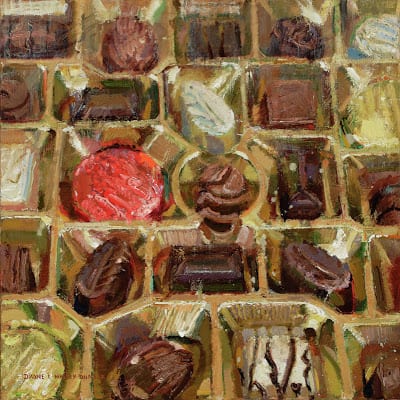
Do you consider the process of painting more important than the result?
I think they are rather inseparable. If the result is a finished painting, you can’t have the result without a process of some sort. And, at some point in time the process of painting ends in a finished piece. I will say that for me, the process greatly influences the result, which includes all my preparation before I begin a painting. I will also admit that for me the most important part of the actual painting is the beginning, because it will set the tone for the remainder of the painting.
No, what I mean is…Do you consider the act of painting itself…one’s personal joy in applying paint, experimenting and creating…more important than the physical result?
I wish I could answer yes to that question because it would be so freeing to let go of the end product and simply enjoy the process of painting. Also, if creating art was merely the act of painting with no regard for the outcome there would not be the inherent fear of failure or the discomfort when we are outside our comfort zone. However, being a professional artist is a career, a business, and so one must consider the end result as well. I think that there needs to be a balance between the creative process and respect for the end result. If it is all about the act of painting, experimenting and being creative, which incidentally can be quite frustrating on occasion, then we are on a journey that does not go anywhere. If it’s all about the end result, I think over time we become bored, don’t take risks, become too comfortable and our art grows stale and predictable. So, I think the process and the end result are inseparable, and I can only hope that as I paint I am aware of and can appreciate the joy and frustration of creating.
Where does creativity come from and how can it be nurtured?
I believe that creativity is a gift from God. I also believe we all have some degree of creativity and that creativity is not reserved for artists, musicians, actors, writers and the like. Everyone from plumbers to lawyers, teachers to advertisers and to builders, all encounter problems that require creativity to resolve. Mulling it over, it seems to me that creativity is often the result of problem solving, curiosity, need, a willingness to explore and a desire to be creative. Creativity also requires imagination and an open mind. To nurture creativity, we need to emphasize and value exploration, give others enough tools and knowledge to be able to explore different options, and offer problems that require imagination and problem solving.
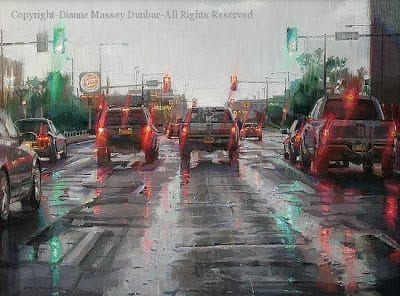
You said in our first interview that you love to play with paint…to smear it, scrape it, splatter and flick it…using all manner of tools. Were you a pretty creative child?
Probably yes. I was rarely interested in playing with dolls or dress up although I loved stuffed animals. What I really liked to do was make things. So I played with Lincoln Logs and Tinkertoys. I had a small tool set with a hammer and saw, and I would use wood and nails to build things. One Christmas I was given a wood burning set so that I could decorate the things I made. I liked crayons. I started drawing at the age of six, and started art lessons and oil painting at age seven. I also use to write…primarily poetry.
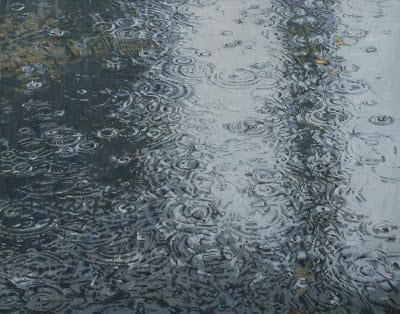
How does your work reflect your personality?
First off, I think I am somewhat sentimental, so much of my work is derived from my life experiences. It is my impression that no matter who we are or what we do, most of life is lived in the ordinary, not in the extraordinary. I think there is something special, maybe even sacred, about the ordinary stuff of life. I want to somehow honor those things we use or images we see in our daily lives that often go unnoticed. I appreciate the ketchup bottle I pulled out of the refrigerator nearly every day when my sons were young. I can find beautiful colors in simple jars. There are surprising greens in a stack of French fries. The world is full of wonderful shapes and color everywhere, even where least expected. I hope that people can see the world a little differently as a result of my painting.
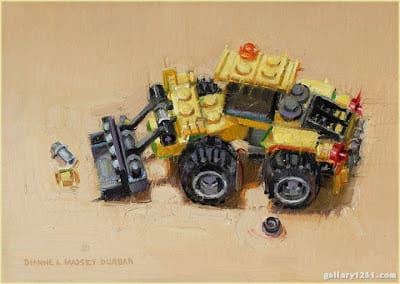
How does one find their individuality as an artist?
I would say finding individuality is a process. Where you begin will likely be very different from where your journey of art ultimately leads you. I also believe that individuality is a result of passion, excitement, exploration, risk taking, failing, succeeding, practicing, and honesty. Paint the subject matter that excites or interests you. Play with paint. Splash it, brush it, knife it, smear it, and make puddles. Try different surfaces because I am learning that they too make a difference. Be creative because after all, we are artists. Some paintings won’t succeed but will boost you to the next painting. Eventually you will have enough paintings behind you, that instead of you finding your individuality, I imagine your individuality will find you.
You use a very extensive palette of colors. How do you manage to maintain control of the color harmony in your paintings?
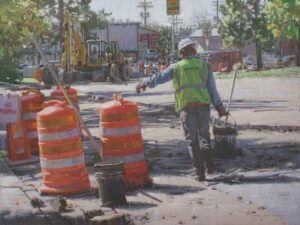
What advice do you have for a young artist/painter?
Making art is a journey and not a sprint. There are no real road maps beyond practicing and attempting to master the basic skills involved. It requires a great deal of passion, commitment, dedication, practice, and courage. Along the way there are wonderful highs and times of utter frustration. Being an artist is not at all what one envisions being an artist should look like. I believe it is about 85% work, 10% fun, and 5% inspiration. Also, I am not at all sure that we choose being artists. I rather think art chooses us. I cannot imagine not painting.
Primarily, I would suggest that you practice drawing. Drawing is absolutely essential to whatever type of art you eventually choose to do. Painting is nothing more or less than the completion of shapes. You need shapes to put value and color on. Those shapes need to be drawn, whether you do abstract art or representational art. I cannot stress the value of drawing enough. Also, if you are having problems with a painting, check your values. I have found that color can be rather forgiving, and that a problem with a painting is more often a value issue. Experiment, play, scrape, and learn what paint does (and doesn’t) do.
Find a mentor; an artist that is better than you, whose opinion you trust and who is willing to critique your work and offer suggestions along the way. Avoid asking others what they think of a painting or project, for opinions are as varied as the weather…and often not helpful. So, get a mentor/teacher to help with this process. Learn from your failures. Take those to your mentor as well.
Don’t be too quick to approach galleries. Everyone wants to be represented by a gallery and many young artists make it their goal to be invited into galleries. Instead, your goal should be to focus on your art and make it as outstanding as possible.
Lastly, keep some of your early work. I have a painting up in my studio from several years ago. When you get discouraged, and you will at times, look at that painting and spend a minute being proud of your progress.
Finally, be aware and prepared for the fact that painting is expensive and for most of us it takes time and practice to get to the point of earning any money.
Workshops, Workshops, Workshops…

It doesn’t matter if you’ve been formally trained or not, or how long you have been painting: if you feel stuck or uninspired as an artist, it can help to take a workshop.

But why not just buy another set of DVDs or the latest how-to book? After all, many of them offer a viable option to the expense and effort of attending a workshop. But books and DVDs are limited by how they are written and can only present a one-way flow of information – even the best of them can’t respond to the way you might learn. When you work face-to-face with an experienced teacher the instruction you receive becomes more fluid and tailored to your capabilities and interests. When you get stuck you can ask the instructor a question, and question the answer, and the teacher has a chance to clarify anything which still may elude you. Painting may not be as complicated as brain surgery or rocket science, but there are times when a little back and forth between you and a real person makes all the difference in the world.
Admittedly, it can be difficult to decide which workshop is best for you. Why? Because you may not know what you don’t know and picking one workshop out of the thousands which are out there can be daunting. It can feel like playing roulette. So again, hedge your bet by asking yourself specific questions such as these: Do you want to learn how to create harmonious color relationships? Do you want to learn how to paint using a limited or extended palette? Do you want to become a loose and expressive alla prima painter, or focus on developing a disciplined multi-session approach? Do you want to learn how to recognize, alter, or transform reality, or do you simply want to paint what you see? These kinds of questions help clarify your goals as you choose a workshop. You can probably come up with many more. (Please post your own questions in the comment section below if you wish to share them with your OPA members. I will read and respond.)
Once you have a better idea of what you want and have settled on a couple of options, contact the instructors and inquire about their teaching methods. Yes, shoot them an email or message them on Facebook. They will respond. Ask for student referrals too. If the teacher you are considering is noted for his or her instruction, then approaching a few students for bona fides will not be awkward. You are just doing your homework like any new student should.
 However, once you’ve signed on, show up fully prepared and ready to go. Your instructor is sacrificing valuable painting time to teach the class so give it your all. Come with an open mind and let him or her deliver the voodoo they do. Accept the expertise and advice they have to offer. Keep what works and discard what doesn’t – after the workshop. Arrive with high expectations for yourself but don’t necessarily expect to produce paintings ready to sell or hang on a wall. The things you will be asked to do may fundamentally challenge your previous working methods, or what once felt safe and comfortable, but still, remain open to what your instructor is offering. Accept that there will be moments of exhilaration and moments of frustration, with all of it impacting the way you paint that day and the weeks and months which follow. It may even feel as though the instructor is sowing seeds for a later harvest as you fumble with the present. If so, then you are in the presence of a master teacher.
However, once you’ve signed on, show up fully prepared and ready to go. Your instructor is sacrificing valuable painting time to teach the class so give it your all. Come with an open mind and let him or her deliver the voodoo they do. Accept the expertise and advice they have to offer. Keep what works and discard what doesn’t – after the workshop. Arrive with high expectations for yourself but don’t necessarily expect to produce paintings ready to sell or hang on a wall. The things you will be asked to do may fundamentally challenge your previous working methods, or what once felt safe and comfortable, but still, remain open to what your instructor is offering. Accept that there will be moments of exhilaration and moments of frustration, with all of it impacting the way you paint that day and the weeks and months which follow. It may even feel as though the instructor is sowing seeds for a later harvest as you fumble with the present. If so, then you are in the presence of a master teacher.
It also means you are likely to continue reaping a rich reward from a short investment of only a few days for years and years to come…
What you should expect from your workshop:
- An immediate but fair evaluation of your present painting ability.
- An clear and effective set of goals scaled to the length of the workshop.
- An instructor who can demonstrate what he or she teaches, and who is fair with the one-on-one contact time.
- An instructor who creates a critical, yet respectful space for you to take a risk in.
- An instructor who can respectfully identify the negative, yet teach with the positive.
- An efficient and organized itinerary appropriate to all students in the class.
What you want to avoid:
- Vague or ill-defined goals for you and the class, or too much improvised instruction.
- Insufficient painting time for you. Demos are fun to watch but you must paint too.
- Instructors who make the class all about themselves. (Hmm…need I say more?)
A few more thoughts…
Here is a hint: If you are thinking about taking a number of workshops over the next few years then consider attending a few national or regional art events to meet and preview potential instructors. When Oil Painters of America presents their yearly exhibitions they often invite signature painters to come and present demos and quick workshops. The same is true, if not more so, for the folks who host the Plein Air Convention and Expos, as it is true for the American Impressionists Society, the Portrait Society of America, and other groups. These events offer you a chance to meet instructors with little fuss or muss, reducing the likelihood you will sign up for an experience that isn’t a good fit. Sure, most of these events charge fees, but weigh those costs against the time and expense of a couple of bad workshops and you may decide the entry ticket is worth it. Plus, while you are there you can network with your fellow artists and talk to those who have already studied with the teachers who most interest you.
However, be wary of guarantees when speaking to a teacher. Be realistic. Even if you do take a workshop from a master painter don’t expect to become a master yourself after taking a single class. And multiple workshops will not make it happen either. What you can learn from the workshops you take is how to become a better painter over time. The unavoidable truth about becoming masterful at anything is there are no short-cuts. A good workshop may save some time by pointing you in the right direction but you still have to clock in the hours yourself. So play the long game. Don’t measure yourself by the successes you experience along the way, measure yourself by the miles of canvas you cover. For it is only through your discipline and practice that the things you struggle with today become reflexive and unconscious tomorrow. That much can be guaranteed.
I hope this post helps you make a good workshop choice. If you are interested in my approach to teaching, and the methods I’ve developed over the last twenty years while working with individuals and groups, as well developing and running an accredited BFA program, visit www.thomaskitts.com. I’d love to hear from you.